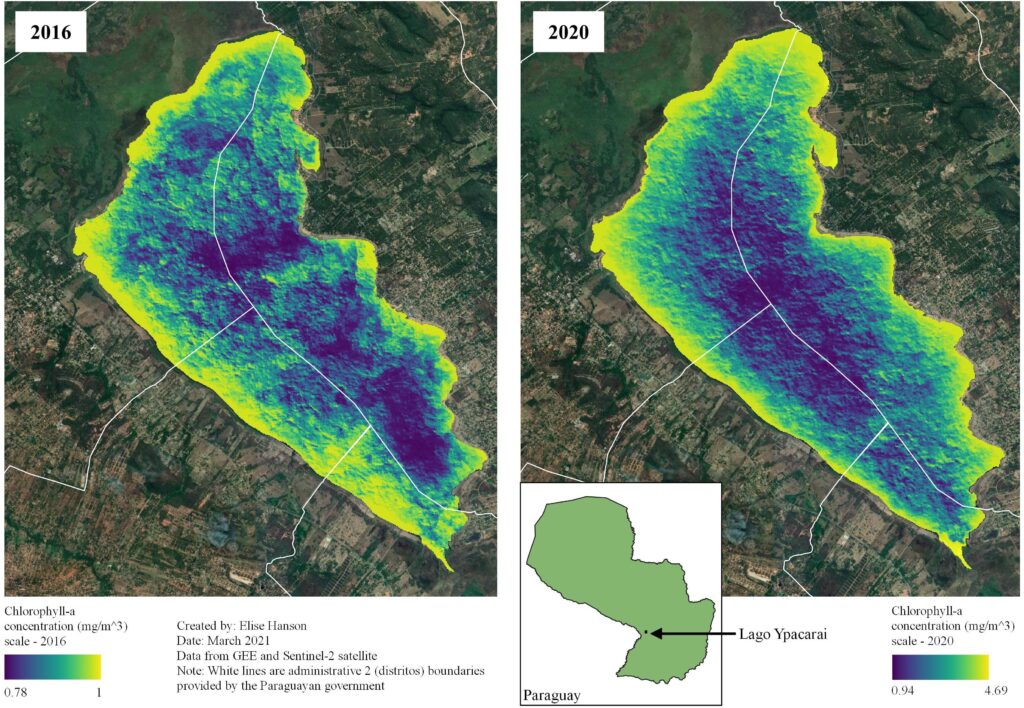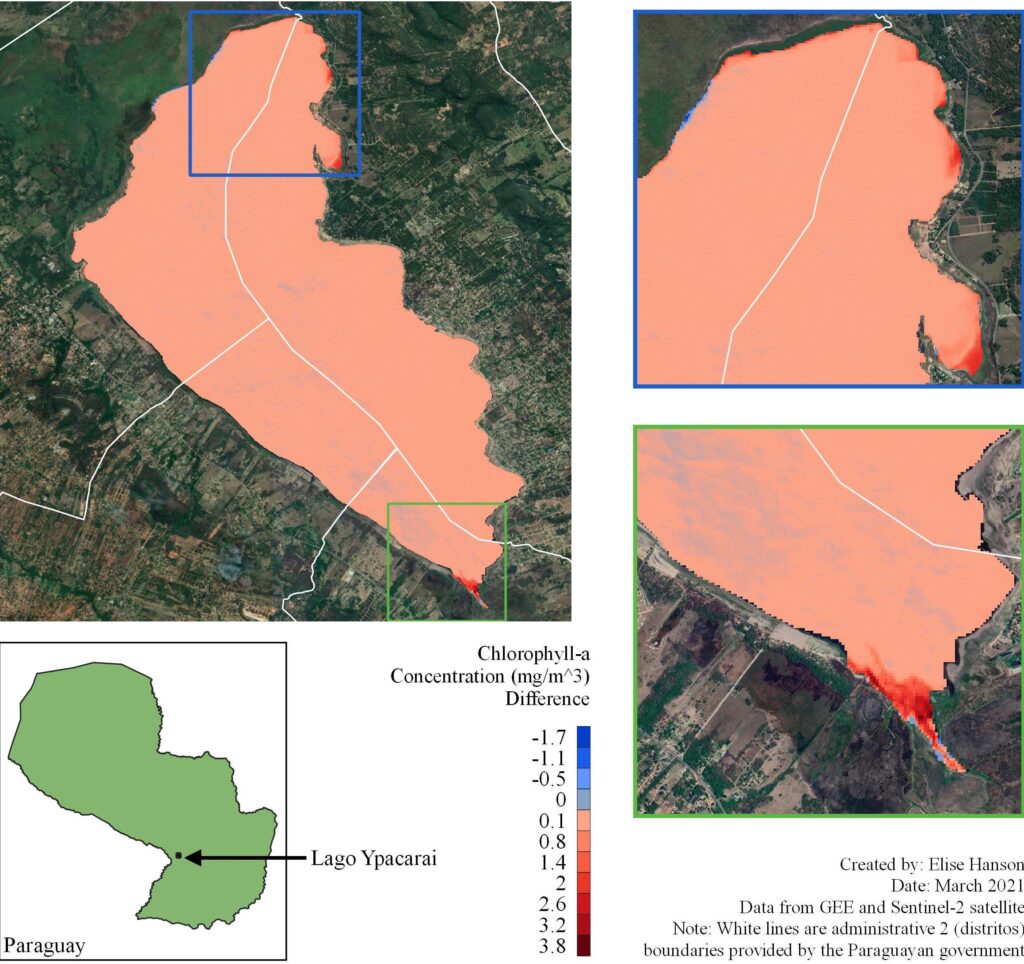Applications for Remotely Assessing Water Quality for Sustainable Development in Paraguay
Remote sensing techniques can be a useful tool to inexpensively detect water quality for nations pursuing SDG Goal 6.
Among the United Nations SDGs is Goal 6, which aims to “ensure availability and sustainable management of water and sanitation for all.” Water quality issues precipitate health and environmental issues, so the SDG indicator 6.3.2, which is a measure of the “proportion of bodies of water with good ambient water quality,” can have outsized impacts on human and ecosystem health.
Measuring “good” water quality, which is defined as water quality that does not have adverse impacts on human or ecosystem health, is time and resource intensive. For countries trying to meet multiple sustainable development goals, time and resources for consistent water quality measures may be scarce.
Satellite imagery and remote sensing are considered to be of secondary importance in indicator 6.3.2 because the primary metrics are chemical compositions of the water, which need to be collected in person. However, remote sensing can still detect water quality anomalies like algal blooms, which can negatively affect both ecosystem functioning and human health and may indicate that the water quality is poor. Ideally, remotely sensed environmental data should be combined with data taken at the site with traditional scientific methods (“ground-truth data”), but absent these verifications, remote sensing can still offer insights into trends and/or seasonality, which can help focus finite restoration and research resources to those areas that are in most need of ground-truth data and government resources. Additionally, these secondary metrics are important for the larger “water quality and wastewater” 6.3 target and can offer proof of concept and cost-savings to national governments.
Thus, this study aimed to understand how satellite imagery of chlorophyll-a, a photosynthetic molecule in algae and plants, could be a proxy for water quality. While neither satellite imagery nor chlorophyll-a directly address indicator 6.3.2, satellite imagery is freely available and data collection and analysis can occur far from the lakes being analyzed. Additionally, remotely sensed chlorophyll-a is well studied and changes rapidly with environmental factors, making it a potentially important water quality proxy for governments.
This study investigated chlorophyll-a concentrations in Lago Yparacaí, a lake in Paraguay near the capital, Asunción, using data from the Sentinel-2 satellite. Sentinel-2 was launched in June 2015, so this paper analyzed annual average chlorophyll-a concentrations per pixel in the lake in 2016 and 2020. As a proof of concept analysis, this comparison was important to see if the average chlorophyll-a concentrations were changing and if those changes were detectable. To measure chlorophyll-a concentrations, this analysis used an equation developed by Zimba and Gitelson (2006) and calculated the average concentration per pixel per year (Figure 1).

The 2016 and 2020 chlorophyll-a concentration averages are starkly different. While the maximum chlorophyll-a concentrations in 2016 were about 1 milligram per cubic meter (mg/m3), the maximum chlorophyll-a concentrations in 2020 were about 4.7 mg/m3, over four times greater than in 2016. While the lake generally saw an increase in chlorophyll-a, the changes were not uniform. Figure 2 shows the changes in concentration from 2016 to 2020 where pixels that are redder increased in concentration from 2016 to 2020 where pixels that are bluer decreased over that time period. The fact that the majority of the lake is a shade of red suggests that most of the lake increased in chlorophyll-a concentration, however, there were decreases in patches of the lake. Notably, shorelines saw the most drastic increases in chlorophyll-a concentrations (Figure 2).

This study suggests that remote sensing is a viable tool for estimating chlorophyll-a concentrations in Lago Ypacaraí and further suggests that remote sensing can have practical applications for monitoring water quality over time. Further, this study suggests that remote sensing can detect areas with the highest concentrations and alert officials to the problem. This may help with responding to slowly increasing algal concentrations by identifying areas where eutrophication may be affecting water quality most drastically. Finally, this study suggests that researchers can regularly and inexpensively monitor the lake remotely and identify anomalous chlorophyll-a concentrations and determine the cause of the anomaly.
Despite the fact that neither remote sensing nor chlorophyll-a are included in the primary indicator 6.3.2 methods, they can nevertheless be utilized by the Paraguayan government to inexpensively monitor Lago Ypacaraí and analyze long-term trends. Further, the Paraguayan government can correlate these changes and heterogeneities with other factors – like precipitation, land use change, covid shutdowns, known or suspected pollution events, or policy changes – to better understand what has been influencing chlorophyll-a concentration changes.
This analysis shows that a widely used model is capable of capturing spatial and temporal heterogeneity and that ground-truth data can help refine the results and make remote sensing a more powerful and accurate tool for measuring water quality. Future studies should create remotely sensed products for other Paraguayan lakes and should incorporate ground-truth data from Lago Ypacaraí and other lakes into a broader remote sensing project to better understand how remote sensing techniques can aid in water quality measurements and to better achieve SDG Goal 6.

